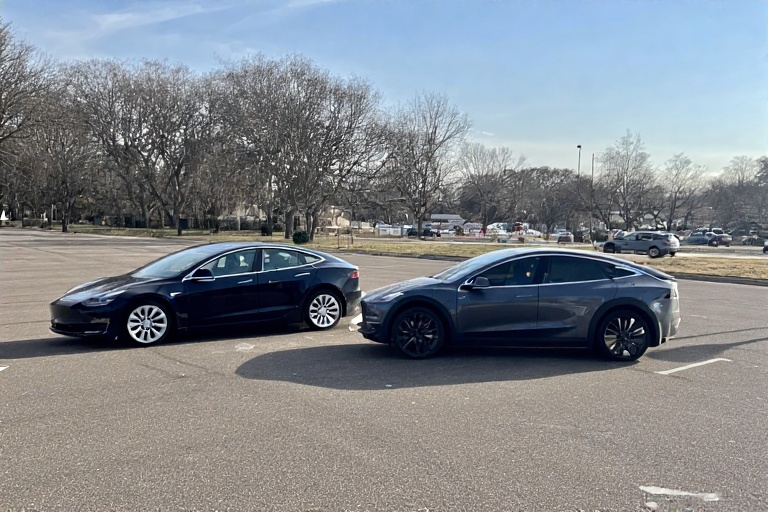Tesla vs BYD is the headline rivalry in the electric vehicle (EV) industry in 2025. As the world shifts to cleaner mobility, these two brands are fighting for global dominance. While Tesla has long been the tech-driven pioneer, BYD has become a volume powerhouse with affordable and reliable EVs.
So, who’s really winning? This in-depth comparison breaks down their strengths, from technology and pricing to market reach and innovation — helping you decide which EV brand is truly leading the future.
Brand Backgrounds: East Meets West
Tesla: The Tech-Driven Disruptor
Founded in 2003 by a group of engineers and now led by Elon Musk, Tesla redefined what electric cars could be. From its Silicon Valley roots, Tesla built a brand around high performance, cutting-edge features like Full Self-Driving (FSD), and a minimalist, futuristic design philosophy. Tesla’s rise shook the automotive industry and set the standard for electric vehicles worldwide.
Tesla’s models — Model 3, Model Y, Cybertruck, and more — have captured imaginations with their sleek designs, software-driven features, and performance specs. Tesla’s vertical integration, including its Gigafactories and proprietary Supercharger network, creates a holistic ecosystem that few competitors can match.
BYD: The Affordable Giant
BYD (Build Your Dreams) started in 1995 as a battery company in China. Over the decades, BYD has grown into the world’s largest EV manufacturer by volume, leveraging its experience in battery production and strong ties to Chinese infrastructure.
Unlike Tesla, BYD focuses on mass-market affordability, appealing especially to price-sensitive markets in Asia, South America, and parts of Europe. BYD produces a wide range of EVs — from the compact Dolphin to the sleek Seal and luxurious Han EV — offering strong value propositions in each segment.
Global Market Share: Who’s Selling More?
As of early 2025, Tesla vs BYD competition has shifted the global landscape. BYD is now officially outselling Tesla in total EV units, marking a significant milestone for the Chinese manufacturer.
| Region | Tesla | BYD |
|---|---|---|
| North America | ✅ Market Leader | ❌ Very limited |
| Europe | Gaining ground | Moderate presence |
| China | Small presence | ✅ Dominant player |
| Global Sales Q1 2025 | ~18% market share | ~21% market share |
While Tesla still commands the premium EV market, BYD’s lower-priced lineup and massive production capabilities have made it the global volume leader. This shift illustrates the dual nature of the EV market — one side driven by high-end innovation, the other by accessibility and scale.
Technology: Who’s More Advanced?
When evaluating Tesla vs BYD technology, Tesla remains the clear leader in several key areas.
- Autonomous Driving: Tesla’s Full Self-Driving (FSD) system offers advanced semi-autonomous capabilities that are unrivaled in the consumer EV market. BYD, on the other hand, offers basic driver assistance but has yet to develop a comparable system.
- Battery Technology: Tesla introduced its revolutionary 4680 battery cells which promise greater range and power density. BYD counters with its Blade Battery, which emphasizes safety and longevity, especially appealing for cost-conscious markets.
- Charging Infrastructure: Tesla’s proprietary Supercharger network ensures fast, reliable charging globally, creating a seamless ownership experience. BYD relies largely on third-party chargers, which can vary in quality and availability.
- Software and User Experience: Tesla leads with its over-the-air (OTA) updates that continuously improve vehicle functionality and user experience. BYD is improving but remains behind Tesla’s software integration and UI polish.
Price & Value: Which Brand Offers More Bang for the Buck?
One of the most significant differentiators in the Tesla vs BYD debate is price.
- BYD offers multiple models starting at very affordable prices. The BYD Dolphin can be purchased for under $20,000 in several markets, making it an ideal choice for first-time EV buyers or budget-conscious consumers.
- Tesla, by contrast, positions itself in the mid to premium price range. The Model 3 starts at around $40,000 in the U.S., with the Model Y and upcoming Cybertruck pushing prices higher.
While Tesla’s pricing reflects its technology leadership and premium build, BYD’s affordability has been key to capturing huge market share, especially in developing economies.
Sustainability & Manufacturing
Both Tesla and BYD prioritize sustainability but approach it differently.
- Tesla has established Gigafactories in the U.S., Germany, China, and Mexico, focusing on renewable energy integration, battery recycling, and sustainable materials. Tesla’s manufacturing plants are moving towards near energy self-sufficiency.
- BYD benefits from vertical integration, producing its own batteries, semiconductors, and other components. Its scale in China and other markets allows it to manufacture at high volumes with efficiency. BYD also invests heavily in electric buses and public transit solutions, which have a massive environmental impact.
User Experience & Design
In the Tesla vs BYD comparison, design and user experience reflect the companies’ different priorities.
- Tesla offers minimalist, futuristic interiors dominated by large touchscreens and digital controls. This tech-forward approach appeals to buyers seeking innovation and sleek aesthetics.
- BYD balances modernity with familiarity, often blending traditional physical controls with digital interfaces. This can appeal to users preferring more conventional driving experiences without sacrificing modern tech.
Tesla’s app ecosystem and vehicle updates continue to impress users, while BYD’s user experience is improving rapidly to keep pace.
Which One Should You Buy?
The choice between Tesla vs BYD boils down to your specific needs:
| Buyer Type | Recommended Brand |
|---|---|
| Tech Enthusiast | Tesla |
| Budget-Conscious | BYD |
| First-Time EV Buyer | BYD |
| Luxury & Performance Seeker | Tesla |
| Based in China or Southeast Asia | BYD |
| Based in U.S., Canada, or Europe | Tesla |
Conclusion: Tesla vs BYD — The Verdict
The Tesla vs BYD rivalry in 2025 is no longer a simple battle for market dominance — it’s a reflection of the EV industry’s evolution.
BYD now leads in volume and affordability, making electric vehicles accessible to millions worldwide. Tesla remains the symbol of innovation, luxury, and advanced technology.
For buyers, the choice depends on priorities: affordability and availability versus cutting-edge features and brand prestige. Either way, Tesla and BYD’s competition is accelerating the global transition to sustainable transportation.




